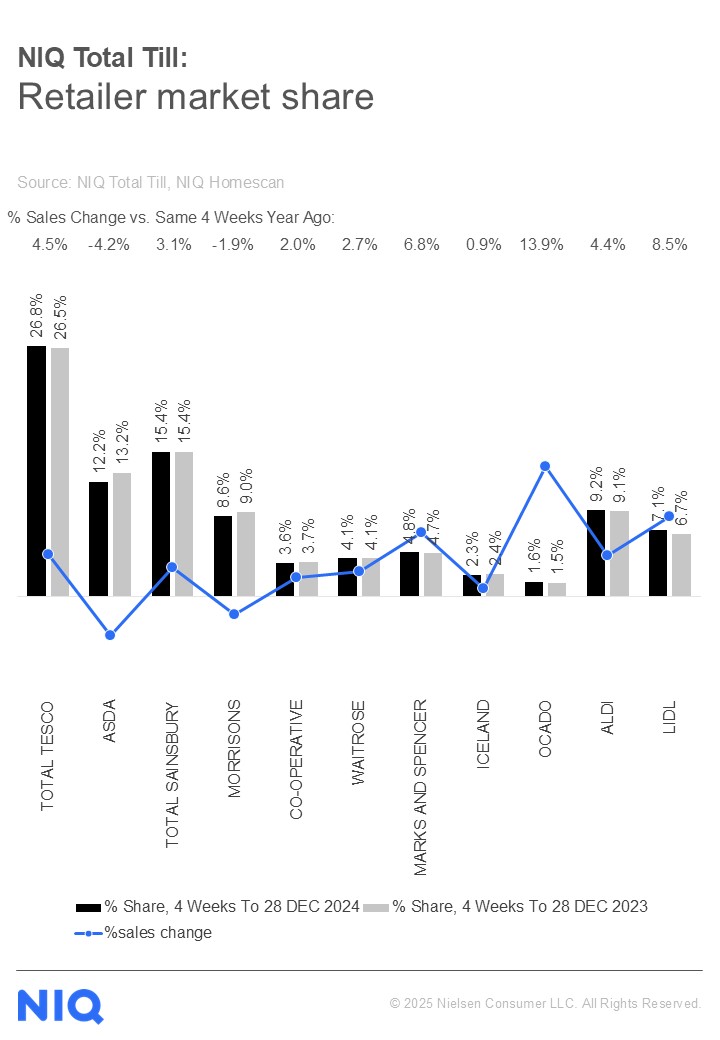- UK grocery hits a record £14.6bn in sales over the final three weeks leading up to Christmas.
- Grocery sales helped by the highest levels of promotions seen in three years, with 27% of all FMCG sales purchased on promotions, 37% of this being driven by brands in the four week period.
- Sales growth in the last 4 weeks was led by Ocado (+13.9%), Marks & Spencer (+6.8%) also fared well – resulting in the highest-ever market share on record – and Tesco (+4.5%) also gained share.
London, 8 January December 2025: Total Till sales growth slowed at UK supermarkets (+3.2%) in the last four weeks ending 28th December 2025, down from +3.7% in the previous month, according to new data released today by NIQ. After a slow start to December 2024, food sales rallied in the final three weeks leading up to Christmas, with sales hitting £14.6bn1, helped by intense discounts and increased promotional activity.
NIQ data reveals over the last four weeks, in-store visits were up +8% helping in-store sales to increase +3.6% on this time last year. This came at the expense of online where sales fell -1.7% with online share falling to 11.9% from 12.5% a year ago. The timing of Christmas Eve will have given a boost to stores with Monday 23rd December the peak shopping day.
Despite the decrease in online share of sales, Ocado (+13.9%) was the fastest-growing retailer over the last four weeks, while the Discounters were the fastest-growing channel (+5.5%). Aldi and Lidl’s combined market share increased to 16.3%, up from 15.8% a year ago. In contrast, trading over the last four weeks was more challenging for the Convenience channel (+2.4%).
Moreover, Tesco (+4.5%) grew market share, with Sainsbury’s (+3.1%) holding market share with both retailers seeing strong increases in visits and new shoppers. Marks & Spencer momentum continued (+6.8%) and this resulted in its highest ever market share of 4.8% on record.
NIQ data shows that in the last four weeks, shoppers put fewer items in their baskets, with an average basket value of £21.95, down (-4.9%) compared to last year. This suggests that shoppers are still bearing the brunt of the high cost of living. This is despite dissipating food inflation at 1.8% compared to 7.8% a year ago.2
Category winners and losers
With shoppers purchasing items to celebrate the festive season with family and friends, NIQ data shows that there was a significant boost in sales for sushi (+20%), olives and antipasti (+10%) as well as chilled bread (+12%), nuts (+10%) and fresh and frozen fruit (+10%).
There was also strong growth across the major supermarkets for fresh produce (+7.4%), bakery (+4.8%) and soft drinks (+3.6%). Sales for meat, fish and poultry also fared better than the same period last year – with value growth up +4.4% and +2.1% in unit growth. Confectionery also did well with +13% value growth and +5.5% unit growth. Health and Beauty also performed well at +6.3%.
NIQ data also shows that sales for beers, wines and spirits fell flat with sales weakening to -1.6% value growth and -1.3% unit growth. However, sales rose for stout (+13%), maybe influenced by the challenges around draft supply of Guinness to pubs.3
Mike Watkins, NIQ’s UK Head of Retailer and Business Insight, said: “In the last four weeks we’ve seen the highest levels of promotions in the last three years, with 27% of all FMCG sales being purchased on promotion, with branded promotions at 37% of sales. This has no doubt helped to boost purchasing over the Christmas period. In particular, this was led by Tesco and Sainsbury’s where promotional spending on FMCG increased to 35% and 34% respectively as these retailers engaged shoppers with big loyalty app savings.
Watkins adds: “Overall, it was a good Christmas for most food retailers with sales growths in line with the expectations that had been set in the last three months. The topline growths were helped by the return of low inflation but also by shoppers being inclined to buy more in the final week leading up to Christmas Eve. However, shoppers still had to spend more money this year on household bills before buying Christmas indulgences and this may have taken the edge off the growth in some other categories such as alcohol and also household.”
Watkins concludes: “Looking ahead to 2025, we expect shoppers to keep managing their budgets by shopping smart and shopping around for wherever the savings are the most attractive. This means that shopping ‘little and often’ will continue with omnichannel shopping becoming an even bigger consumer trend across the industry.”

Table: 12-weekly % share of grocery market spend by retailer and value sales % change.
Notes
Unless otherwise stated all data is NIQ Homescan Total Till
1 NIQ Scantrack Total Coverage
2 BRC NIQ SPI November 2024
3 NIQ Scantrack Grocery Multiples
About NIQ Homescan Total Till
NIQ’s continuous panel of 30,000 GB households and our widest read of retailer performance is designed to measure household purchasing through major supermarkets intended for in-home consumption and brought back into the home. It includes all food and drink, household, and personal care and an estimate of non-food spend (e.g. clothing, electrical, cards and stationery, newspapers & magazines, toys, music, general merchandise, etc.).
About NIQ
NielsenIQ (NIQ) is the world’s leading consumer intelligence company, delivering the most complete understanding of consumer buying behavior and revealing new pathways to growth. NIQ combined with GfK in 2023, bringing together the two industry leaders with unparalleled global reach. Today NIQ has operations in more than 95 countries covering 97% of GDP. With a holistic retail read and the most comprehensive consumer insights—delivered with advanced analytics through state-of-the-art platforms—NIQ delivers the Full View™.
For more information, please visit www.niq.com

